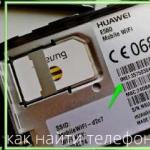HOW TO LEARN TO WORK ON A COMPUTER IN TWO HOURS
Can a common person master a computer in two hours? Surely the majority will answer this question in the negative. I have a different opinion. If children begin to play with the computer after learning to walk a little, then why do many middle-aged and older people find it difficult to master this complex household tool? I believe that the reason for this is the lack of a professional approach to the system of teaching computer work.
Ordinary people from the post-Soviet states, whose knowledge base was laid back in Soviet times, are simply used to thinking in other categories. Their minds have a different terminology, they are used to thinking in other criteria (more precisely, in other templates). What happens when they pick up any book on computers? The first thing they come across is incomprehensible terms that mean even less understandable categories. Interface, modem, processor, controller, etc. - all this scares away and discourages any desire to take up the development of a computer. And sometimes these terms even have a polysemantic meaning (for example, the word "processor" as such, and the same word in the phrase " word processor"Already have different meanings). Do children learn the computer with the help of these boring technical books and memorize these incomprehensible terms? Yes, of course not. For them, a computer is a toy with which you need to play according to certain rules (the word algorithm for many of them is not yet clear).
To begin with, I needed to teach my father, who is 87 years old, to play chess on his own with a computer. To do this, I wrote the instructions, which formed the basis of this article. In addition, I have a friend who is afraid of the computer like fire, and for any offer to use the computer, he triggers a defensive reaction, and he immediately says, "I don't need that." Therefore, I decided to post on the site the instructions that I wrote for my 87-year-old father, and according to which he could easily use my computer.
The purpose of this article is to help middle-aged and older people, and possibly children, master this incomprehensible thing - a computer in a few hours. I say it again, if you got to my site, then you do not need this article. But on the other hand, it may be needed by your younger brother, father or comrade, for the training of which you, naturally, do not have time.
To learn how to use a computer (as they say now, to master a computer at the level of a novice user), you need to learn how to do four things:
1. Turn on the computer.
2. Run the program you need (it is best to start with some simple game). In most cases application programs installed on your computer are indicated by a small image (pictogram or icon), which are reflected (highlighted, you can call it whatever you like) on the computer desktop (you will find the concept of this term a little below, but do not get hung up for now).
3. Turn off the program you are running. This operation is called - "close the program".
4. Turn off your computer.
Let's start by looking at a few concepts. Apparently, I also cannot do without theory, probably, this is how we, people of the older generation, are arranged. But I assure you, the theory will not take more than five minutes and, perhaps, will help some people learn the computer faster. What is a computer? This is a gizmo that usually consists of a small box (called a system unit) and a screen (called a monitor). It happens that both the system unit and the monitor are combined with each other. Then such a computer, depending on its size, can be called a laptop, netbook, tablet, smartphone, communicator or something else. The image that appears on the monitor screen after turning on the computer and after the completion of all transients is called the desktop (see Fig. 1). everything shown in Fig. 1 is the desktop. Of course, for each computer, the images on the desktop may be different.
Elements of Fig. 1, which are necessary for the first lesson: 1 - pictograms (icons) of programs; 2 - Solitaire game icon; 3 - Start button.
Any computer can only work with programs. Roughly speaking, programs are the rules by which a computer operates. If there are no rules, the computer will not work. In general, programs can be divided into two types. The first type is the operating system - this is main program, which is "put" into a computer so that it can work. The task of the operating system is to manage all other programs. The second type is application programs (roughly they can be called auxiliary), with the help of these programs specific tasks are performed on the computer (watching movies, photographs, listening to music, playing various games, etc.). Well, perhaps that's all, the theory is over for today. Let's move on to practice.
In order to use your computer, you must first turn it on. To do this, on any computer, as well as on any household appliance or any electronic toy, there is a special power button. Usually this button is located on system unit... For your specific computer, you will find the location of this button in its instruction manual (description), or ask a more experienced friend, but be sure to remember where it is located, otherwise you will not be able to turn on your computer again.
After you turn on your computer, a cursor will appear on its screen (usually it is a small oblique arrow, but there may be something else - a cross or a vertical line of risk). Owners of tablets or smartphones do not have a cursor; its task is performed by your finger or stylus (a special plastic stick). The cursor is controlled using the so-called mouse, which is moved along flat surface causes the cursor to move on the desktop. The program you need is launched by hovering the cursor over the icon of this program and double-clicking (clicking, or clicking) the left mouse button (LMB) while holding the cursor on the icon of the program you have chosen. The image that appears on the monitor after the transients are completed when the program is started is called the program window. In our case, I started the game "Solitaire", using the corresponding icon (see 2 Fig.1), selecting it from a set of other icons (see 1 Fig.1) and got the Solitaire program window Fig.2. How to work with a specific program is another question, and perhaps in my other tutorials for beginners, I will try to describe this process for the most popular programs. Owners of tablets (smartphones, etc.) in order to start the program need to touch the stylus (or finger) to the icon of the required program.

So, in the screenshot of Fig. 2 (by the way, the screenshot is taken with special program designed specifically for this purpose) presents a popular game "solitaire", which you can learn to play by consulting with a computer user of any level, at least with a neighbor's boy. Why do I recommend starting your computer exploration with a game? Yes, because it will not be so tiring, you will quickly learn to control the mouse and will be able to master the first basics of the process of communicating with a computer.
To turn off the computer, just hover the cursor over the "Start" button on the desktop and press the left mouse button once while holding the cursor on this button. The "Start" button is a small figure in the lower left corner (see 3 Fig.1), it can have the shape of a circle, like mine, or a rectangle. It depends on the operating system on your computer. After you press the start button (left-click with the cursor on the "Start" button), depending on your computer, you will see a small window Fig. 3, in which you must select the "Shutdown" item (or "Turn off the computer") (see 1 Fig. 3). If you move the cursor over it (at this inscription) and press the left mouse button, the computer will turn off after a while. I draw your attention to the fact that on your computer the image in Fig. 3 may differ from mine, but you still need to look for the words "Shutdown" or "Turn off the computer". I also want to draw your attention to the fact that the "Start" button is not the button with which you turned on the computer, that real button is called the power button, but this one drawn is called the "Start" button. Perhaps it would be more correct to call this button the Off button (although it has other purposes as well).

If you did it all yourself, congratulations, you can already be ranked among the novice users.
I deliberately skipped one point in this manual. This is the shutdown of the program that you started. For most programs, this is not necessary, but there are programs in which it is necessary to save the current parameters so as not to start work (game) from the beginning. But the order of saving the parameters is individual for each program, and the order of performing this operation should be considered when studying specific program... And to turn off (complete) the program, it is usually enough (this applies to most, but still not all programs) to point at the white cross in the red rectangle, which is located in the upper right corner of the program window (see 1 Fig. 2) and press the left mouse button. And it would be nice if the user made it a habit to close all programs running by him, although, I repeat, this is not necessary.
Itsenko Alexander Ivanovich
This article belongs to the series of articles “ Computer training " or " Master a computer in two hours ". Other articles from this series:
I present to your attention the best, in my opinion, at the moment tutorial for working on a computer in Windows 7... I don't even know how to describe it. It has everything - from the little things, the basics of working at the computer, to the description of the system settings. You will learn how to install Windows 7, customize the system for yourself, use all kinds of built-in Windows tools 7.
In short, the whole system is described in full, in detail and intelligibly. In addition, popular programs are described: Word and Excel in detail. And all this with illustrations and examples. I highly recommend it. It would probably take me half a year to create such a guide about Windows 7. Huge respect and respect to the author of this creation - Sergey Vavilov!
To open this tutorial you need PDF reader... I recommend using Foxit Reader.
Download tutorial for working on a computer in Windows 7 (13.7 Mb)
2.Computer for beginners
I can also advise you on another excellent self-study guide " Computer for beginners"From Alexey Lebedev. Perhaps it will be even better than the one described above. I just found it later. I strongly advise you to familiarize yourself with it - you will not regret it, I assure you.

Download the tutorial "Computer for beginners" (8.9 Mb)
3 all the secrets of the internet - a netizen's handbook

I described this book already in a separate article, you can take a look at what it will give you before deciding to download.
Download "All the secrets of the Internet" (63 Mb)
![]()
Do not be intimidated by the large size of the book - the link is not from Letitbit and swings very quickly.
4. Computer Doctor-1

An excellent book by Evgeny Khokhryakov on computer security.
Disclosed all the nuances of protecting your computer from any threats. Naturally, with examples and pictures. The quality is amazing.
Greetings, dear blog visitors. In touch with you, as always, Dmitry Smirnov, the author of the sowing blog. In this article I want to tell you about how to study a computer, actually how to learn how to work on a computer and what is needed for this!

Since the beginning of the 21st century, people have become much more active in using various kinds of technology. Most devices are extremely easy for a person to master, but as for computers, this is another more difficult question. The fastest way to learn new computers and gadgets is children, and this happens because they do not fool themselves for a long time, reading various literature. Toddlers want to practically touch and press everything, and in the course of such research they learn what to do and how to do it. Adults take this issue more seriously, they are afraid to experiment in order to avoid equipment breakdowns and other unpleasant moments. Every adult, and especially an elderly person, wants to learn how to learn how to work on a computer quickly and, most importantly, without financial investments. By the way, in the last article I wrote about
At first glance, the process of teaching computer literacy seems very difficult, older people consider this an unattainable goal for themselves. Opening the guide to this technical device everyone immediately begins to get scared of the complex and incomprehensible terminology, but it turns out that it is not so scary.
If we consider in detail the auxiliary literature in the form of an application guide, you can figure out that the names and terms that are incomprehensible to a person denote a part of a computer or software. If a term is not clear in the instructions, you can always find step by step guide with detailed explanations in the form of pictures.
When a person has figured out the instructions, turned on the computer, he needs to learn how to work on it - to print texts, run various programs, work on the Internet and deal with both the creation and storage of multimedia files.
The beginner will be able to see the first clues directly on the monitor. Many icons and pictograms due to their appearance give a person a specific hint, an exact indication of what is hidden behind them. For example, if an image of a note is visible in a small picture, a person will guess that he is dealing with music player rather than from the settings menu. The same settings can be displayed on the wrench icon. This story repeats itself with almost all programs on the desktop.
When a person beginning to work with a computer figured out intuitively what image is hidden behind it, it is time to check it in practice. This raises the question of how to do this, because with such a multitude of buttons, you don't always understand which one you need to press.
The keyboard is a good thing, but in this case you need to do without it. For this there is PC mouse... To direct the cursor - an arrow to the desired object, you need to scroll the small wheel located on the mouse between the two buttons. By moving the cursor to the object that needs to be opened immediately on the monitor, you can see the name of the object or the text indicating its purpose.
In order to open the desired object, you need to double-click on the mouse button located on the right side. After opening the program, many stop at this, not knowing how to work with it. But in reality it is not that difficult. Almost every program or game has step by step explanation how to use it.
The main condition in order to quickly master the nuances of computer literacy is to perform all actions independently without outside help. Having learned to work with the software, many people cannot master the skills of printing for a very long time. In the beginning, it's hard to even find a letter on the keyboard. To quickly learn this, you do not need to read any literature or ask someone.
In order to learn to print there are online simulators that stimulate the observation of a person and are able to focus his attention on a specific object or symbol. This is done very quickly and a person, without noticing it, very quickly gets used to the keyboard layout, even in spite of it he knows where everything is. Thus, you can already safely type with two hands.
Now, there are many online training courses, but in most cases they are all paid. In order not to spend money on training from the Internet, you can download special applications absolutely free of charge. Thanks to such small, simple programs, you can quickly learn to work with the corresponding software, presentations, text documents and discover other fascinating possibilities of the computer mechanism.
Thinking about how to learn how to work on a computer, you can come to the conclusion that this is quickly done with the help of screenshots - screenshots of the same computer, which shows what and how to do. A person sees a snapshot of the screen and the actions performed on it, thanks to this, he focuses on his computer and eats to do the same. If there is a reason to be afraid that your own actions will not be remembered, you can take a screenshot yourself - this is done by pressing a special button on the keyboard.
Working on a computer only at first glance seems difficult and incomprehensible, but in fact everything is extremely simple and you can get used to it very quickly. The main thing in the learning process is the availability of daily practical classes, because without them even the most understandable courses and programs will not be able to help anyone.
The younger generation very quickly masters computer technology due to their courage and willingness to experiment - this is exactly what older people lack and becomes a mechanism that slows them down.
Drawing conclusions in the topic of how to learn how to work on a computer, we can say the following - fast learning depends on the assertiveness of a person and his readiness for new experiments. In life, almost always everything seems difficult and unattainable, but when you soberly assess the situation and come closer to the problem, it will turn out to be a funny little thing. This is the case with a computer - do not be afraid of complex terms and a large number of unfamiliar programs, if you open them all in turn and try to work in a couple of days, you can become a computer pro.
Now you know how to learn a computer!
Have you never worked with a computer? You look with envy at teenagers knocking on the keyboard, who in a matter of seconds find any information that interests them, communicate online with friends or play unknown to you computer games? Do you dream of buying a laptop (or you already have new computer) and learn how to do your job with their help at the level of a confident PC user, discovering the boundless world of the World Wide Web? Do you want to improve your professional level and learn the secrets of working with Word, Excel, Outlook Express - the programs you need for your daily work? Come to our computer courses!
Computer literacy courses will allow you to quickly and efficiently master the basics of working with a personal computer and study the basic programs necessary for organizing your daily work. In a computer class for dummies, starting with the basics of working in Windows (the basis of the studied software), acquaintance with the concepts of "file", "folder", "taskbar", "desktop", "shortcut", "window", you will study step by step basic operator terminology personal computer and master the skills of working with electronic media. You will not need to constantly look for outside help to create a document, find desired file or a folder, configure a mouse, keyboard or install the program you need. You will acquire the skills to operate the basic functions of your PC and master the work with text, spreadsheets, learn basic Internet terminology.
Computer training will allow you to easily edit, format documents, and will reveal the secrets of working with the basic functions of the Word text editor. Having learned how to work with tables in Excel, with by e-mail thanks to the capabilities of Outlook Express, you will appreciate how convenient your PC skills are in practice. Educational material focused on the course "Computer for beginners", therefore, computer literacy training is carried out at an accessible level with an explanation and practical application each function being studied.
After completing computer training, you will acquire the necessary modern world universal computerization of knowledge of a confident PC user, confirmed by a certificate of completion of computer courses. You will significantly improve your professional level and get the basics of computer literacy for the subsequent development of your own skills and abilities, self-improvement, as well as the basis for the subsequent study of new computer programs that interest you.
- you will get to know operating system windows
- learn about software your computer
- learn to create, modify and delete folders and files
- learn to work in text editor word
- learn to add to text documents pictures, texts, tables, etc.
- learn to work in excel
- you will learn how to create tables, charts, graphs in excel
- learn to work on the Internet
- you will understand all the subtleties of creating your own mailbox
- learn to register and communicate on social networks

Upon completion of the course, you will receive
Upon completion of the PC course for beginners, you will receive a certificate with the assignment of a specialty:"Personal computer operator".
![]()
PowerPoint course - designed to create presentations,
Access Course - Lets you create and administer databases.
![]()
Where will you study?
Addresses of classrooms in which classes are held for the selected courses *:m.Kurskaya- main sales office, 4 computer labs, 3 theory classes, 2 design classes
m.Belorusskaya - theory class
M. Kuznetsky Most- classes of beauty courses
metro Oktyabrskaya - computer classes, theory classes
m. Prospect Mira - computer classes, theory classes
M. Pushkinskaya - classes of beauty courses
m.Serpukhovskaya - computer classes, theory classes
m.Sokol - computer classes, theory classes
m.Taganskaya - computer classes, theory classes
M. Tretyakovskaya - classes of beauty courses
(* The exact address classroom, check with the organizer of the educational process)




